1000+ Anatomy of flowering plant MCQ for RRB ALP [Solved]
Thursday 9th of March 2023

Sharing is caring
1. When we peel the skin of a potato tuber, we remove
A. periderm
B. epidermis
C. cuticle
D. leaves
Answer : A
A. periderm
B. epidermis
C. cuticle
D. leaves
Answer : A
2. Cork cambium and vascular cambium are
A. the parts of secondary xylem and phloem.
B. the parts of pericycle.
C. lateral meristems.
D. apical meristems.
Answer : C
A. the parts of secondary xylem and phloem.
B. the parts of pericycle.
C. lateral meristems.
D. apical meristems.
Answer : C
3. Cambium is considered as a lateral meristem because
A. it gives rise to lateral branches.
B. it causes increase in girth.
C. it increases height and diameter of a plant.
D. it adds bulk to a plant.
Answer : B
A. it gives rise to lateral branches.
B. it causes increase in girth.
C. it increases height and diameter of a plant.
D. it adds bulk to a plant.
Answer : B
4. Which of the following statements is correct?
A. Lenticels occur in most woody trees.
B. Sclerenchymatous cells are usually present in cortex.
C. The vascular tissue system is divided into three main zones- cortex, pericycle and pith.
D. The conjoint vascular bundles usually have the xylem located only on the outer side of the phloem.
Answer : A
A. Lenticels occur in most woody trees.
B. Sclerenchymatous cells are usually present in cortex.
C. The vascular tissue system is divided into three main zones- cortex, pericycle and pith.
D. The conjoint vascular bundles usually have the xylem located only on the outer side of the phloem.
Answer : A
5. T.S. of dicot stem is given below, certain parts have been marked by alphabets (A I). Choose the option which shows their correct labelling.

A. A Epidermis, B Epidermal hair, C Parenchyma, D Starch sheath, E Hypodermis (collenchyma), F Vascular bundle, G Bundle cap, H Medulla or pith, I Medullary rays
B. A Epidermal hair, B Epidermis, C Hypodermis (collenchyma), D Parenchyma, E Endoderm is (Starch Sheath), F Pericycle, G Vascular bundle, H Medullary rays, I Medulla or pith
C. A Epidermal hair, B Epidermis, C Hypodermis (collenchyma), D Starch sheath, E Parenchyma, F Vascular bundle, G Bundle cap, H Medulla or pith, I Medullary rays
D. A Epidermal hair, B Epidermis, C Parenchyma, D Hypodermis (collenchyma), E Starch sheath, F Vascular bundle, G Bundle cap, H Medulla or pith, I Medullary rays
Answer : B

A. A Epidermis, B Epidermal hair, C Parenchyma, D Starch sheath, E Hypodermis (collenchyma), F Vascular bundle, G Bundle cap, H Medulla or pith, I Medullary rays
B. A Epidermal hair, B Epidermis, C Hypodermis (collenchyma), D Parenchyma, E Endoderm is (Starch Sheath), F Pericycle, G Vascular bundle, H Medullary rays, I Medulla or pith
C. A Epidermal hair, B Epidermis, C Hypodermis (collenchyma), D Starch sheath, E Parenchyma, F Vascular bundle, G Bundle cap, H Medulla or pith, I Medullary rays
D. A Epidermal hair, B Epidermis, C Parenchyma, D Hypodermis (collenchyma), E Starch sheath, F Vascular bundle, G Bundle cap, H Medulla or pith, I Medullary rays
Answer : B
6. In the given columns, column I contain structures of female reproductive system and column II contain its feature. Select the correct match.
A. A - (i), B - (ii), C - (iii), D - (iv)
B. A - (iii), B - (i), C - (ii), D - (iv)
C. A - (i), B - (iv), C - (iii), D - (ii)
D. A - (ii), B - (iv), C - (iii), D - (i)
Answer : A
| Column-I | Column-II |
|---|---|
| A. Lateral meristem | (i) Fascicular vascular cambium, interfascicular cambium and cork cambium. |
| B. Apical meristem | (ii) Produces dermal tissue, ground tissues and vascular tissue. |
| C. Bast fibres | (iii) Generally absent in primary phloem but found in secondary phloem. |
| D. Sap wood | (iv) Involved in the conduction of water and minerals from the root to leaf. |
A. A - (i), B - (ii), C - (iii), D - (iv)
B. A - (iii), B - (i), C - (ii), D - (iv)
C. A - (i), B - (iv), C - (iii), D - (ii)
D. A - (ii), B - (iv), C - (iii), D - (i)
Answer : A
7. Which meristem helps in increasing girth?
A. Lateral meristem
B. Intercalary meristem
C. Primary meristem
D. Apical meristem
Answer : A
A. Lateral meristem
B. Intercalary meristem
C. Primary meristem
D. Apical meristem
Answer : A
8. In an experiment, a student cut a transverse section of young stem of a plant which he has taken from his school garden.
After observing it under the microscope how would he ascertain whether it is a monocot stem or a dicot stem?
A. With the help of bulliform cells.
B. With the help of casparian strips.
C. With the help of vascular bundles.
D. With the help of stomatal apparatus.
Answer : C
After observing it under the microscope how would he ascertain whether it is a monocot stem or a dicot stem?
A. With the help of bulliform cells.
B. With the help of casparian strips.
C. With the help of vascular bundles.
D. With the help of stomatal apparatus.
Answer : C
9. The trees growing in desert will
A. show alternate rings of xylem and sclerenchyma.
B. have only conjunctive tissue and phloem is formed by the activity of cambium.
C. show distinct annual rings.
D. not show distinct annual rings.
Answer : D
A. show alternate rings of xylem and sclerenchyma.
B. have only conjunctive tissue and phloem is formed by the activity of cambium.
C. show distinct annual rings.
D. not show distinct annual rings.
Answer : D
10. A plant tissue when stained showed the presence of hemicellulose and pectin in cells wall of its cells. The tissue is called
A. collenchyma
B. sclerenchyma
C. xylem
D. meristem
Answer : A
A. collenchyma
B. sclerenchyma
C. xylem
D. meristem
Answer : A
11. Identify types of vascular bundles in given figures A, B and C.
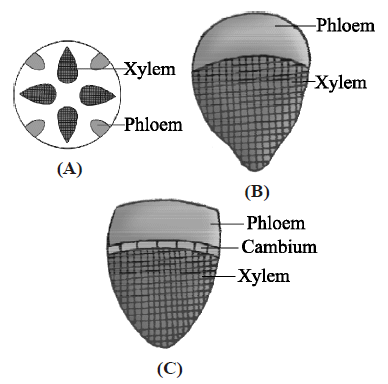
A. Radial; Conjoint closed; Conjoint open
B. Conjoint closed; Conjoint open; Radial
C. Conjoint open; Conjoint closed; Radial
D. Bicollateral; Concentric; Radial
Answer : A

A. Radial; Conjoint closed; Conjoint open
B. Conjoint closed; Conjoint open; Radial
C. Conjoint open; Conjoint closed; Radial
D. Bicollateral; Concentric; Radial
Answer : A
12. The given figure shows T.S. of monocot stem. Identify the correct labelling of A to F marked in the given figure.
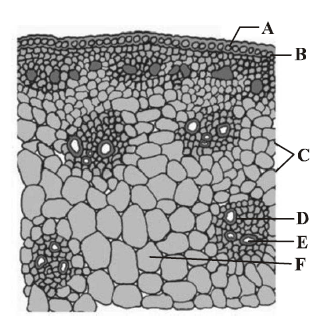
A. A Epidermis, B Hypodermis, C Vascular bundles, D Phloem, E Xylem, F Ground tissue
B. A Cuticle, B Epidermis, C Sclerenchymatous sheath, D Sclerenchymatous hypodermis, E Parenchymatous sheath, F Phloem
C. A Cuticle, B Epidermis, C Sclerenchymatous hypodermis, D Sclerenchymatous sheath, E Parenchymatous sheath, F Phloem
D. A Cuticle, B Epidermis, C Sclerenchymatous hypodermis, D Sclerenchymatous sheath, E Parenchymatous sheath, F Protoxylem
Answer : A

A. A Epidermis, B Hypodermis, C Vascular bundles, D Phloem, E Xylem, F Ground tissue
B. A Cuticle, B Epidermis, C Sclerenchymatous sheath, D Sclerenchymatous hypodermis, E Parenchymatous sheath, F Phloem
C. A Cuticle, B Epidermis, C Sclerenchymatous hypodermis, D Sclerenchymatous sheath, E Parenchymatous sheath, F Phloem
D. A Cuticle, B Epidermis, C Sclerenchymatous hypodermis, D Sclerenchymatous sheath, E Parenchymatous sheath, F Protoxylem
Answer : A
13. Which of the following statements are correct ?
A. (i) and (iii)
B. (i) and (ii)
C. (iii) and (iv)
D. (i) and (iv)
Answer : B
- Xylem transports water and minerals.
- Gymnosperms lack sieve tubes and companion cells in phloem.
- The first formed primary xylem is called metaxylem.
- Phloem fibres (bast fibres) are made up of collenchymatous cells.
A. (i) and (iii)
B. (i) and (ii)
C. (iii) and (iv)
D. (i) and (iv)
Answer : B
14. Bast fibres are made up of _____________cells.
A. sclerenchymatous
B. chlorenchymatous
C. parenchymatous
D. aerenchymatous
Answer : A
A. sclerenchymatous
B. chlorenchymatous
C. parenchymatous
D. aerenchymatous
Answer : A
15. As secondary growth proceeds, in a dicot stem, the thickness of
A. sapwood increases.
B. heartwood increase.
C. both sapwood and heartwood increases.
D. both sapwood and heartwood remains the same.
Answer : C
A. sapwood increases.
B. heartwood increase.
C. both sapwood and heartwood increases.
D. both sapwood and heartwood remains the same.
Answer : C
16. The given figure shows apical meristem of root apex with few part marked as A, B and C. Identify the correct labelling of A, B and C.
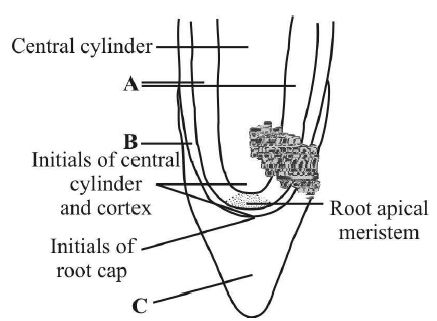
A. A Vascular structure, B Protoderm, C Root cap
B. A Cortex, B Endodermis, C Root cap
C. A Cortex, B Protoderm, C Root cap
D. A Tunica, B Protoderm, C Root cap
Answer : C

A. A Vascular structure, B Protoderm, C Root cap
B. A Cortex, B Endodermis, C Root cap
C. A Cortex, B Protoderm, C Root cap
D. A Tunica, B Protoderm, C Root cap
Answer : C
17. The given diagrams show stomatal apparatus in dicots and monocots. Which one is correct option for A, B and C?

A. A Epidermal cells; B Subsidiary cells; C chloroplast
B. A Guard cells; B Subsidiary cells; C Stomatal pore
C. A Guard cells; B Epidermal cells; C Guard cells
D. A Epidermal cells; B Subsidiary cells; C Guard cells
Answer : D

A. A Epidermal cells; B Subsidiary cells; C chloroplast
B. A Guard cells; B Subsidiary cells; C Stomatal pore
C. A Guard cells; B Epidermal cells; C Guard cells
D. A Epidermal cells; B Subsidiary cells; C Guard cells
Answer : D
18. The length of different internodes in a culm of sugarcane is variable because of
A. size of leaf lamina at the node below each internode
B. intercalary meristem
C. shoot apical meristem
D. position of axillary buds
Answer : B
A. size of leaf lamina at the node below each internode
B. intercalary meristem
C. shoot apical meristem
D. position of axillary buds
Answer : B
19. Sieve tubes are suited for translocation of food because they possess
A. bordered pits.
B. no ends walls.
C. broader lumen and perforated cross walls.
D. no protoplasm.
Answer : C
A. bordered pits.
B. no ends walls.
C. broader lumen and perforated cross walls.
D. no protoplasm.
Answer : C
20. Which of the following process helps the trichomes in preventing water loss?
A. Where companion cells helps in maintaining the pressure gradient in the sieve tubes.
B. Where plants absorb water through the roots and then give off water vapor through pores in their leaves.
C. Where activity of cork cambium builds pressure on the remaining layers peripheral to phellogen and ultimately these layers dies and slough off.
D. None of the above
Answer : B
A. Where companion cells helps in maintaining the pressure gradient in the sieve tubes.
B. Where plants absorb water through the roots and then give off water vapor through pores in their leaves.
C. Where activity of cork cambium builds pressure on the remaining layers peripheral to phellogen and ultimately these layers dies and slough off.
D. None of the above
Answer : B
21. In land plants, the guard cells differ from other epidermal cells in having
A. cytoskeleton.
B. mitochondria.
C. endoplasmic reticulum.
D. chloroplasts.
Answer : D
A. cytoskeleton.
B. mitochondria.
C. endoplasmic reticulum.
D. chloroplasts.
Answer : D
22. Match the terms given in column I with their funciton given in column II and choose the correct option.
A. A I, B III, C V, D II, E IV
B. A III, B I, C II, D V, E IV
C. A II, B IV, C V, D I, E III
D. A V, B IV, C III, D II, E I
Answer : B
| Column-I | Column-II |
|---|---|
| (Term) | (Functions) |
| A. Meristem | I. Photosynthesis, storage |
| B. Parenchyma | II. Mechanical support |
| C. Collenchyma | III. Actively dividing cells |
| D. Sclerenchyma | IV. Stomata |
| E. Epidermal tissue | V. Sclereids |
A. A I, B III, C V, D II, E IV
B. A III, B I, C II, D V, E IV
C. A II, B IV, C V, D I, E III
D. A V, B IV, C III, D II, E I
Answer : B
23. Match the elements of xylem given in column I with their character given in the column II and choose the correct option.
A. A IV; B III; C II; D I
B. A III; B II; C I; D IV
C. A II; B I; C IV; D III
D. A III; B IV; C II; D I
Answer : D
| Column-I | Column-II |
|---|---|
| A. Xylem vessels | I. Store food materials |
| B. Xylem tracheids | II. Obliterated lumen |
| C. Xylem fibres | III. Perforated plates |
| D. Xylem parenchyma | IV. Chisel-like ends |
A. A IV; B III; C II; D I
B. A III; B II; C I; D IV
C. A II; B I; C IV; D III
D. A III; B IV; C II; D I
Answer : D
24. Gymnosperms are also called soft wood spermatophytes because they lack
A. cambium
B. phloem fibres
C. thick-walled tracheids
D. xylem fibres
Answer : D
A. cambium
B. phloem fibres
C. thick-walled tracheids
D. xylem fibres
Answer : D
25. Apical, intercalary and lateral meristems are differentiated on the basis of
A. origin
B. function
C. position
D. development
Answer : C
A. origin
B. function
C. position
D. development
Answer : C
26. T.S. of dicot leaf passing through the midrib is given below. Certain parts have been marked by alphabets (A to H). Choose the option showing their correct labelling.

A. A Epidermis, B Spongy mesophyll, C Palisade mesophyll, D Stomata, E Guard cells, F Phloem, G Metaxylem, H Protoxylem
B. A Epidermis, B Palisade mesophyll, C Spongy mesophyll, D Sub-stomatal cavity, E Stoma, F Phloem, G Xylem, H Bundle sheath
C. A Epidermis, B Palisade mesophyll, C Spongy mesophyll, D Stomata, E Guard cells, F Epidermis, G Xylem, H Phloem
D. A Epidermis, C Palisade mesophyll, C Spongy mesophyll, D Stomata, E Guard cells, F Phloem, G Metaxylem, H Protoxylem
Answer : B

A. A Epidermis, B Spongy mesophyll, C Palisade mesophyll, D Stomata, E Guard cells, F Phloem, G Metaxylem, H Protoxylem
B. A Epidermis, B Palisade mesophyll, C Spongy mesophyll, D Sub-stomatal cavity, E Stoma, F Phloem, G Xylem, H Bundle sheath
C. A Epidermis, B Palisade mesophyll, C Spongy mesophyll, D Stomata, E Guard cells, F Epidermis, G Xylem, H Phloem
D. A Epidermis, C Palisade mesophyll, C Spongy mesophyll, D Stomata, E Guard cells, F Phloem, G Metaxylem, H Protoxylem
Answer : B
27. Trees at sea do not have annual rings because
A. soil is sandy.
B. there is climatic variation.
C. there is no marked climatic variation.
D. there is enough moisture in the atmosphere.
Answer : C
A. soil is sandy.
B. there is climatic variation.
C. there is no marked climatic variation.
D. there is enough moisture in the atmosphere.
Answer : C
28. Phellogen and phellem respectively denote
A. cork and cork cambium,
B. cork cambium and cork,
C. secondary cortex and cork,
D. cork and secondary cortex,
Answer : B
A. cork and cork cambium,
B. cork cambium and cork,
C. secondary cortex and cork,
D. cork and secondary cortex,
Answer : B
29. A vascular bundle in which the protoxylem is pointing to the periphery is called __________.
A. endarch
B. exarch
C. radial
D. closed
Answer : B
A. endarch
B. exarch
C. radial
D. closed
Answer : B
30. Which one of the following option shows the correct labelling of the parts marked as A, B, C and D in the given figure of a typical dicot root?
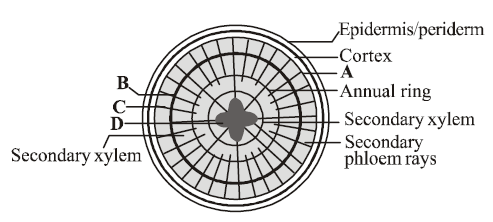
A. A Primary phloem, B Vascular cambium, C Secondary phloem, D Pimary xylem
B. A Secondary phloem, B Vascular cambium, C Primary phloem, D Primary xylem
C. A Primary phloem, B Primary xylem, C Secondary phloem, D Vascular cambium
D. A Secondary phloem, B Primary xylem, C Primary phloem, D Vascular cambium
Answer : A

A. A Primary phloem, B Vascular cambium, C Secondary phloem, D Pimary xylem
B. A Secondary phloem, B Vascular cambium, C Primary phloem, D Primary xylem
C. A Primary phloem, B Primary xylem, C Secondary phloem, D Vascular cambium
D. A Secondary phloem, B Primary xylem, C Primary phloem, D Vascular cambium
Answer : A
31. Which one of the following have vessels as their characteristic feature?
A. Angiosperms
B. Gymnosperms
C. Pteridophytes
D. Bryophytes
Answer : A
A. Angiosperms
B. Gymnosperms
C. Pteridophytes
D. Bryophytes
Answer : A
32. A narrow layer of thin walled cells found between phloem/ bark and wood of a dicot is
A. cork cambium
B. vascular cambium
C. endodermis
D. both (a) & (c)
Answer : B
A. cork cambium
B. vascular cambium
C. endodermis
D. both (a) & (c)
Answer : B
33. Lignin is the important constituent in the cell wall of
A. phloem
B. parenchyma
C. xylem
D. cambium
Answer : C
A. phloem
B. parenchyma
C. xylem
D. cambium
Answer : C
34. An organised and differentiated cellular structure having cytoplasm but no nucleus is called _________.
A. vessels
B. xylem parenchyma
C. sieve tubes
D. tracheids
Answer : C
A. vessels
B. xylem parenchyma
C. sieve tubes
D. tracheids
Answer : C
35. The __________ occurs in layers below the epidermis in dicotyledonous plants.
A. parenchyma
B. sclerenchyma
C. collenchyma
D. aerenchyma
Answer : C
A. parenchyma
B. sclerenchyma
C. collenchyma
D. aerenchyma
Answer : C
36. Match column-I with column-II and select the correct option from the codes given below.
A. A IV, B I, C II, D III
B. A III, B II, C I, D IV
C. A I, B II, C III, D IV
D. A IV, B II, C I, D III
Answer : A
| Column-I | Column-II |
|---|---|
| A. Stele | I. Innermost layer of cortex |
| B. Endodermis | II. Suberin |
| C. Casparian strips | III. All the tissues exterior to vascular cambium |
| D. Bark | IV. All the tissues inner to endodermis |
A. A IV, B I, C II, D III
B. A III, B II, C I, D IV
C. A I, B II, C III, D IV
D. A IV, B II, C I, D III
Answer : A
37. A student was given a tissue to observe under the microscope. He observes the tissue and concludes that the tissue is a type of simple plant tissue and provides mechanical support to young stem and petiole of leaf.
Identify the tissue.
A. Parenchyma
B. Collenchyma
C. Sclerenchyma
D. Xylem parenchyma
Answer : B
Identify the tissue.
A. Parenchyma
B. Collenchyma
C. Sclerenchyma
D. Xylem parenchyma
Answer : B
38. Match column-I with column-II and choose the correct option.
A. A III, B V, C IV, D I, E II
B. A II, B V, C I, D III, E IV
C. A II, B IV, C I, D III, E V
D. A III, B I, C V, D II, E IV
Answer : D
| Column -I | Column -II |
|---|---|
| A. Bulliform cells | I. Initiation of lateral roots |
| B. Pericycle | II. Root |
| C. Endarch xylem | III. Grasses |
| D. Exarch xylem | IV. Dicot leaf |
| E. Bundle sheath cells | V. Stem |
A. A III, B V, C IV, D I, E II
B. A II, B V, C I, D III, E IV
C. A II, B IV, C I, D III, E V
D. A III, B I, C V, D II, E IV
Answer : D
39. The given figure shows the T.S of dicot root. Some parts are marked as A, B, C, D, E, & F. Choose the option which shows the correct labelling of marked part.

A. A Epiblema, B Root hair, C Cortex, D Endodermis, E Pith, F Pericycle
B. A Cortex, B Pith, C Epiblema, D Endodermis, E Root hair, F Pericycle
C. A Epiblema, B Endodermis, C Cortex, D Root hair, E Pith, F Pericycle
D. A Cortex, B Epiblema, C Pith, D Endodermis, E Root hair, F Pericycle
Answer : D

A. A Epiblema, B Root hair, C Cortex, D Endodermis, E Pith, F Pericycle
B. A Cortex, B Pith, C Epiblema, D Endodermis, E Root hair, F Pericycle
C. A Epiblema, B Endodermis, C Cortex, D Root hair, E Pith, F Pericycle
D. A Cortex, B Epiblema, C Pith, D Endodermis, E Root hair, F Pericycle
Answer : D
40. In stems, the protoxylem lies towards the _____________ and the metaxylem lies towards the ____________ of the organ.
A. centre; periphery
B. periphery; centre
C. periphery; periphery
D. centre; centre
Answer : A
A. centre; periphery
B. periphery; centre
C. periphery; periphery
D. centre; centre
Answer : A
41. Which type of plant tissue is being described by the given statements?
A. Parenchyma
B. Sclerenchyma
C. Collenchyma
D. Chlorenchyma
Answer : B
- It consists of long, narrow cells with thick and lignified cell walls having a few or numerous pits.
- They are dead and without protoplasts.
- On the basis of variation in form, structure, origin and development, it may be either fibres or sclereids.
- It provides mechanical support to organs.
A. Parenchyma
B. Sclerenchyma
C. Collenchyma
D. Chlorenchyma
Answer : B
42. Sclerenchyma usually___________and_____________ protoplasts.
A. live, without
B. dead, with
C. live, with
D. dead, without
Answer : D
A. live, without
B. dead, with
C. live, with
D. dead, without
Answer : D
43. Cork is formed from
A. phellogen
B. vascular cambium
C. phloem
D. xylem
Answer : A
A. phellogen
B. vascular cambium
C. phloem
D. xylem
Answer : A
44. Identify A, B and C in the given figure of shoot apical meristem
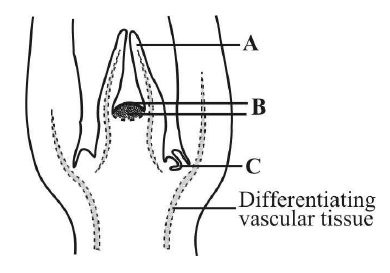
A. A Leaf primordium, B Shoot apical meristem, C Axillary bud
B. A Leaf primordium, B Shoot apical meristem, C Apical bud
C. A Root hair primordium, B Root apical meristem, C Axillary bud
D. A Root hair primordium, B Root apical meristem, C Terminal bud
Answer : A

A. A Leaf primordium, B Shoot apical meristem, C Axillary bud
B. A Leaf primordium, B Shoot apical meristem, C Apical bud
C. A Root hair primordium, B Root apical meristem, C Axillary bud
D. A Root hair primordium, B Root apical meristem, C Terminal bud
Answer : A
45. Xylem functions as a conducting tissue for water and minerals from _________to the ______and__________.
A. roots, stems, leaves
B. stems, roots, leaves
C. leaves, stems, roots
D. leaves, stems, leaves
Answer : A
A. roots, stems, leaves
B. stems, roots, leaves
C. leaves, stems, roots
D. leaves, stems, leaves
Answer : A
46. The apical meristem of the root is present
A. in all the roots.
B. only in radicals.
C. only in tap roots.
D. only in adventitious roots.
Answer : A
A. in all the roots.
B. only in radicals.
C. only in tap roots.
D. only in adventitious roots.
Answer : A
47. In the given figure of phloem tissue, identify the marked part (A, B and C) which help in maintaining the pressure gradient
in the sievetubes.
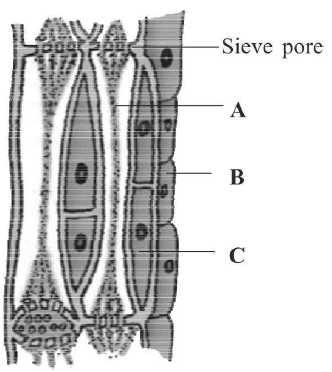
A. A
B. B
C. C
D. None of the above
Answer : C
in the sievetubes.

A. A
B. B
C. C
D. None of the above
Answer : C
48. Various functions like photosynthesis, storage, excretion performed by _____________.
A. sclerenchyma
B. parenchyma
C. collenchyma
D. aerenchyma
Answer : B
A. sclerenchyma
B. parenchyma
C. collenchyma
D. aerenchyma
Answer : B
49. Cells of permanent tissues are specialized
A. functionally.
B. only structurally.
C. both structurally and functionally.
D. for mitosis.
Answer : C
A. functionally.
B. only structurally.
C. both structurally and functionally.
D. for mitosis.
Answer : C
50. Which of following helps bamboo and grasses to elongate ?
A. Apical meristems
B. Lateral meristems
C. Secondary meristems
D. Intercalary meristems
Answer : D
A. Apical meristems
B. Lateral meristems
C. Secondary meristems
D. Intercalary meristems
Answer : D
Sharing is caring
Related Post
ESIC - Machine Design 1000+ MCQ [Solved] PDF Download
NDA - Synthesis of Sentences 1000+ MCQ [Solved] PDF Download
1000+ Fill in the blanks MCQ for XAT [Solved]
1000+ Sentence Correction MCQ for IBPS RRB [Solved]
Active and Passive Voice MCQ Solved Paper for RRB NTPC
Current Affairs November 2022 1000+ MCQ with answer for RRB Group D